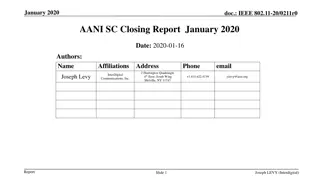
Buffers in Physical Pharmacy
Learn about buffers in physical pharmacy, which are important compounds that resist changes in pH when small quantities of acid or alkali are added. Explore the buffer equation, buffered solutions, common ion effect, and how weak acids and bases play a role in maintaining pH stability.
Download Presentation

Please find below an Image/Link to download the presentation.
The content on the website is provided AS IS for your information and personal use only. It may not be sold, licensed, or shared on other websites without obtaining consent from the author. If you encounter any issues during the download, it is possible that the publisher has removed the file from their server.
You are allowed to download the files provided on this website for personal or commercial use, subject to the condition that they are used lawfully. All files are the property of their respective owners.
The content on the website is provided AS IS for your information and personal use only. It may not be sold, licensed, or shared on other websites without obtaining consent from the author.
E N D
Presentation Transcript
Lecturer Ghaidaa S Hameed Physical pharmacy
Buffers are compounds or mixtures of compounds that, by their presence in solution, resist changes in pH upon the addition of small quantities of acid or alkali. The resistance to a change in pH is known as bufferaction.
Buffered Solutions 0.1N HCl 1ml HAc, NaAc H2O NaCl pH 4.7 pH 7 pH 7 4.58 3 3 3
Buffered Solutions Combination of a weak acid and its conjugate base HA+ OH- A-+H2O Combination of a weak base and its conjugate acid HA + OH- A- + H3O+ 5
The Buffer Equation A Weak Acid and Its Salt If the strong acid is added to a 0.01 M solution containing equal quantities of acetic acid and sodium acetate, the pH is changed only 0.09 pH units because the base Ac- ties up the hydrogen ions according to the reaction
HAc + H2O K1[HAc][H2O] = K2[H3O+][Ac-] H3O+ + Ac- salt [H3O+][Ac-] [HAc] Ka = acid -log[H3O+]= - logKa - log[acid] + log[salt] 7
A Weak Acid and Its Salt pH= pKa+log[salt] [acid] Buffer equation or Henderson-Hasselbalch equation Dissociation exponent 8
Common ion effect * When Sod. acetate is added to acetic acid [H3O+][Ac-] [HAc] Ka = is momentarily disturbed since the acetate ion supplied by the salt increases the [Ac-] HAc + H2O H3O+ + Ac- The ionization of HAc is repressed upon the addition of the common ion [Ac-] 9
The Buffer Equation A Weak Base and Its Salt B + H2O OH- + BH+ salt [OH-][BH+] [B] Kb= base 10
A weak base and its salt [base] [salt] [OH-] = Kb [H3O+] [OH-] = Kw -log[H3O+]= - logKw log1/Kb - log[salt]/[base] 11
A Weak Acid and Its Salt pH= pKw- pKb+ log[base] [salt] * Buffers are not ordinarily prepared from weak bases because of the volatility & instability of the bases and because of the dependence of their pH on pKw, which is often affected by temp. changes. 12
Example For example, when sodium acetate is added to acetic acid, the dissociation constant for the weak acid,is Is momentarily disturbed because the acetate ion supplied by the salt increases the [Ac-] term in the numerator.
To reestablish the constant Ka at 1.75 10-5, the hydrogen ion term in the numerator [H3O+] is instantaneously decreased, with a corresponding increase in [HAc]. Therefore, the constant Ka remains unaltered, and the equilibrium is shifted in the direction of the reactants. Consequently, the ionization of acetic acid is repressed upon the addition of the common ion, Ac-. This is an example of the common ion effect.
What is the molar ratio, [Salt]/[Acid], required to prepare an acetate buffer of pH 5.0? Also express the result in mole percent.
Therefore, the mole ratio of salt to acid is 1.74/1. Mole percent is mole fraction multiplied by 100. The mole fraction of salt in the salt acid mixture is 1.74/(1 + 1.74) = 0.635, and in mole percent, the result is 63.5%.
Factors influencing the PH of buffer solutions 1. Altering the ionic strength Addition of neutral salts Dilution (alter activity coefficients) 2. Temperature The pH of the most basic buffer was found to change more markedly with temp. than that of acid buffers, owing to Kw.
pH indicator Acid indicator HIn + H2O Acid color H3O+ + In- Alkaline color base [H3O+ ][ In-] [HIn] KIn = acid 18
[base] [acid] 1/10~10/1 pH = pKIn + log * From experience, one cannot discern a change from the acid color to the salt color the ratio of [base] to [acid] is about 1 to 10 * The effective range of the indicator is pH =pKIn + 1 10/1 1/10 acid base 19
Characteristics of colorimetric method less accurate less convenient but less expensive than electrometric method difficult to apply for the unbuffered pharmaceutical preparation (change the pH - indicator itself is acids or base) error may be introduced by the presence of salts & proteins 20
Buffer capacity the magnitude of the resistance of a buffer to pH changes B pH = = buffer capacity = buffer efficiency = buffer index = buffer value B : small increment in gram equivalents/Liter of strong base (or acid) added to the buffer soln. to produce a pH change of pH 21
+ NaOH HAc + H2O NaAC (0.1+ 0.01) (0.1- 0.01) 0.01 Before the addition of NaOH [salt] [acid] pH=pKa + log = 4.76 After the addition of NaOH pH=pKa + log[salt] + [base] = 4.85 [acid] - [base] B 0.01 0.09 = = = 0.11 pH 22
As can be seen from Table 8-1, the buffer capacity is not a fixed value for a given buffer system but instead depends on the amount of base added. The buffer capacity changes as the ratio log([Salt]/[Acid]) increases with added base. With the addition of more sodium hydroxide, the buffer capacity decreases rapidly, and, when sufficient base has been added to convert the acid completely into sodium ions and acetate ions, the solution no longer possesses an acid reserve.
The buffer has its greatest capacity before any base is added, where [Salt]/[Acid] = 1, and, therefore, pH = pKa. The buffer capacity is also influenced by an increase in the total concentration of the buffer constituents because, obviously, a great concentration of salt and acid provides a greater alkaline and acid reserve.
A more exact equation for buffer capacity (1914, 1922) Ka [H3O+] = 2.3 C (Ka + [H3O+])2 c : total buffer conc.(sum of the molar conc. of the acid & the salt) . ---- at any [H3O+] 26
Maximum Buffer capacity max occurs where pH = pKa, ([H3O+] = Ka) [H3O+]2 2.303 C max = 2.303 C (2 [H3O+])2= 4 max = 0.576 C ( pH = pKa ) 27
Characteristics of Buffer Capacity is not a fixed value, but rather depend on the amount of base added depends on the value of the ratio [salt]/[acid] and magnitude of the individual concentrations of the buffer components The greatest capacity( max) occurs where [salt]/[acid] = 1 and pH = pKa Because of interionic effects, buffer capacities do not in general exceed a value of 0.2 28
Universal Buffer Total buffer capacity of a universal buffer (combination of several buffers) 29
Buffers in Pharmaceutical and Biologic Systems In Vivo Biologic Buffer Systems Blood is maintained at a pH of about 7.4 by : Primary buffers in the plasma : The plasma contains carbonic acid/bicarbonate and acid/alkali sodium salts of phosphoric acid as buffers Secondary buffers in the erythrocytes: hemoglobin/oxyhemoglobin and acid/alkali potassium salts of phosphoric acid. Plasma proteins, which behave as acids in blood, can combine with bases and so act as buffers.
It is usually life-threatening for the pH of the blood to go below 6.9 or above 7.8. The pH of the blood in diabetic coma is as low as about 6.8. Lacrimal fluid, or tears, have been found to have a great degree of buffer capacity, allowing a dilution of 1:15 with neutral distilled water before an alteration of pH is noticed. The pH of tears is about 7.4, with a range of 7 to 8 or slightly higher. Urine pH: 6.0 (range 4.5 7.8) below normal hydrogen ions are excreted by the kidney. above pH 7.4 hydrogen ions are retained by action of the kidney.
Influence of Buffer Capacity and pH on Tissue Irritation Solutions to be applied to tissues or administered parenterally are liable to cause irritation if their pH is greatly different from the normal pH of the relevant body fluid. Consequently, the pharmacist must consider when formulating ophthalmic products: 1. its buffer capacity and 2. the volume to be used in relation to the volume of body fluid with which the buffered solution will come in contact. 3. The buffer capacity of the body fluid should also be considered. solutions, parenteral
Tissue irritation, due to large pH differences between the solution being administered and the physiologic environment in which it is used, will be minimal : A. the lower is the buffer capacity of the solution, B. the smaller is the volume used for a given concentration.
Martin and Mims found that Srensen's phosphate buffer produced irritation in the eyes of a number of individuals when used outside the narrow pH range of 6.5 to 8, whereas a boric acid solution of pH 5 produced no discomfort in the eyes of the same individuals. It can be explained partly in terms of the low buffer capacity of boric acid as compared with that of the phosphate buffer and partly to the difference of the physiologic response to various ion species.
Preparation of pharmaceutical buffer solutions Steps for development of a new buffer Select a weak acid having a pKa approximately equal to the pH at which the buffer is to be used. Calculate the ratio of salt & weak acid required to obtain the desired pH. Consider the individual conc. Of the buffer salt & acid needed to obtain a suitable buffer capacity * Individual conc. : 0.05 ~ 0.5M * buffer capacity : 0.01 ~ 0.1 36
Preparation of pharmaceutical buffer solutions Steps for development of a new buffer Availability of chemicals, sterility of the final soln, stability of the drug & buffer, cost of materials, freedom from toxicity ex) borate buffer toxic effect not be used for oral or parenteral products. Determine the pH and buffer capacity using a reliable pH meter 37
Stability vs. optium therapeutic response * Undissociated form of a weakly acidic or basic drug has a higher therapeutic activity than the dissociated salt form. * Molecular form is lipid soluble & can penetrate body membranes readily, where the ionic form, not being lipid soluble, can penetrate membranes only with greater difficulty. 38
The solution of the drug can be buffered at a low buffer capacity and at a pH that is a compromise between that of optimum stability and the pH for maximum therapeutic action. The buffer is adequate to prevent changes in pH due to the alkalinity of the glass or acidity of CO2 from dissolved air. Yet, when the solution is instilled in the eye, the tears participate in the gradual neutralization of the solution; Conversion of the drug occurs from the physiologically inactive form to the undissociated base. The base can then readily penetrate the lipoidal membrane. As the base is absorbed at the pH of the eye, more of the salt is converted into base to preserve the constancy of pKb; hence, the alkaloidal drug is gradually absorbed.
pH and solubility * Influence of buffering on the solubility of base - At a low pH : base is in the ionic form & usually very soluble in aqueous media - As the pH is raised : more undissociated base is formed when the amount of base exceeds the limited water solubility of this form, free base precipitates from soln. Base soln. should be buffered at a sufficiently low pH for stabilization against precipitation. 40
Example 8-10 Mole Percent of Free Base The pKb of pilocarpine is 7.15 at 25 C. Compute the mole percent of free base present at 25 C and at a pH of 7.4 and 4.
Example (Pilocarpine base) C11H16N2O2H+ + OH- (Pilocarpine ion) [salt] At pH 4.0 4.0 = 14 7.15+ log C11H16N2O2 + H2O pH= pKw- pKb+ log[base] At pH 7.4 7.4 = 14 7.15+ log[base] [base] [salt] [salt] [base] [salt] [base] [salt]= 3.56 / 1 = 0.0014 / 1 Mole percent of base = 0.0014 / (1 + 0.0014) 100 = 0.13% Mole percent of base = 3.56 / (1 + 3.56) 100 = 78% 42 SKKU Physical Pharmacy Laboratory
Buffered Isotonic Solutions In addition to carrying out pH adjustment, pharmaceutical solutions that are meant for application to delicate membranes of the body should also be adjusted to approximately the same osmotic pressure as that of the body fluids. Isotonic solutions cause no swelling or contraction of the tissues with which they come in contact and produce no discomfort when instilled in the eye, nasal tract, blood, or other body tissues.
If a small quantity of blood, is mixed with a solution containing 0.9 g of NaCl per 100 mL, the cells retain their normal size. The solution has essentially the same salt concentration and hence the same osmotic pressure as the red blood cell contents and is said to be isotonic with blood. If the red blood cells are suspended in a 2.0% NaCl solution, the water within the cells passes through the cell membrane in an attempt to dilute the surrounding salt solution until the salt concentrations on both sides of the erythrocyte membrane are identical. This outward passage of water causes the cells to shrink and become wrinkled . The salt solution in this instance is said to be hypertonic with respect to the blood cell contents.
Finally, if the blood is mixed with 0.2% NaCl solution or with distilled water, water enters the blood cells, causing them to swell and finally burst, with the liberation of hemoglobin. This phenomenon is known as hemolysis, and the weak salt solution or water is said to be hypotonic with respect to the blood.
Buffered isotonic solution Red blood cell 0.9 % Isotonic 2.0 % 0.2 % NaCl solution Hypertonic, Shrink Hypotonic, Hemolysis SKKU Physical Pharmacy Laboratory
Measurement of Tonicity The tonicity of solutions can be determined by one of two methods: First, a quantitative method based on the fact that a hypotonic solution liberates oxyhemoglobin in direct proportion to the number of cells hemolyzed. By such means, the van't Hoff i factor can be determined.
The second approach used to measure tonicity is based on any of the methods that determine colligative properties. It is now well established that -0.52 C is the freezing point of both human blood and lacrimal fluid. This temperature corresponds to the freezing point of a 0.90% NaCl solution, which is therefore considered to be isotonic with both blood and lacrimal fluid.
Calculating Tonicity Using Liso values The Van t Hoff expression Tf = L c Molal freezing point depression of water Liso = Tf / c Conc. that is isotonic with body fluids 0.52 SKKU Physical Pharmacy Laboratory 49
Calculating Tonicity Using Liso Values This specific value of L is written as Liso. It has a value equal to : Liso for non electrolyte= 1.9 ( sucrose) Liso for weak electrolyte = 2 ( zinc sulfate) Liso for uni-univalent electrolyte = 3.4 (NaCL) Liso for uni-divalent electrolyte = 4.3 (Na2SO4) Liso for di-divalent electrolyte = 4.8 (CaCl2)











